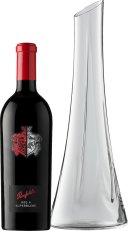Penfolds Super Blend 802A Cabernet Shiraz With Nick Mount Decanter
One Superblend. Two Interpretations. Curiosity and experimentation delivers two new wines made from parcels destined for Penfolds flagships: Superblend 802.A and 802.B Cabernet Shiraz. Carefully selected from the coveted 2018 South Australian vintage, the wines represent two unique interpretations of the iconic Australian blend of cabernet sauvignon and shiraz. 802.A components were aged separately in new American oak hogsheads for 22 months prior to being blended. The cabernet sauvignon makes its structural presence felt comprising 68% of the blend, while the 32% shiraz contribution adds generosity. Unashamedly bold, immediately Penfolds.
Chris Ringland Shiraz
Chris Ringland Shiraz 2005 represents an outstanding expression from the vineyard. The vine is powerful, voluptuous and ripe, yet the tannins are plush and mature, with moderate acidity. This vintage will have great longevity potential.
Château Ausone Saint-Émilion
Named after the Roman poet Ausonius in the 18th century, Château Ausone still sits on a site scattered with Roman ruins to this day. In 1976, Pascal Delbeck took control and Ausone's reputation has soared. Now with 'flying consultant' Michel Rolland at the helm of the winemaking team, the wines have become ultra-rich, stylish and veluptuous. The 2009 in particular is a wine of true immense proportions. The vintage conditions were shining on those in Saint-Émilion and the opulence of the estate is balanced by the fine structure and ripe tannins of the 09 which will see the wine further develop for the next 40 years. Unfortunatley only 1,200 cases were made and availability will be extremely limited.
Château Angélus Saint-Emilion
A very important estate in St-Émilion, Château Angélus was acquired by the de Boüard de Laforest family in 1924 and merged with the previously owned Château Mazerat. The apostrophe was dropped in 1989 and is now simply known as Angélus. The wines are characterised by a fabulous texture offered by the high component of Cabernet Franc with the plump softness added by the Merlot creating a wine of pleasing plushness.
Chateau Trotanoy
Chateau Leoville-Las-Cases 2me cru classe
With one of the longest and most pedigreed histories in the Medoc region, Chateau Leoville-Las-Cases has passed through the hands of some of Frances most notable and wealthiest noble families, culminating in the Las Cases family - the final royal family to hold title to the Chateau. Up until the French Revolution, after which large portions of it were sold off, it was one of the largest vineyards in Bordeaux. Today, the estate remains family owned by the Delons, of which brother Jean Hubert and sister Genevieve manage proceedings. Famed for producing a wine of structure, power, and traditional style, the 2016 vintage has earned outstandingly high praise, including a score of 100 from Andrew Caillared and a 19/20 from Jancis Robinson who praised its extraordinary vitality and energy and proclaimed it glorious to taste now.
Château Ausone St-Émilion 1er Grand Cru 'A'
Tasted blind at the 2012 Southwold tasting, the 2012 Ausone took more time to settle in the glass than its peers, eventually deciding upon briary, violet and cassis scentsvery floral and Margaux-like in style, not powerful but insistent. The palate is medium-bodied with fine tannin, a crisp line of acidity, blackcurrant pastille mixed with cedar and a dash of spice, the wine finally revving up towards an intense and persistent finish that almost stains the mouth with its opulence. It is a gorgeous Saint Emilion from Pauline and Alain Vauthier. Tasted January 2016. - Rober Parker Jr
Chris Ringland Hoffmann Vineyard Barossa Shiraz
The Hoffmann Vineyard Shiraz is a tête de cuvée (literally ‘head of the blend’) style. Key parts of the vineyard, with vines between 60 and 100 years old, are picked at different stages of ripeness, resulting in five separate two-tonne grape parcels ultimately filling 20 barrels. The final wine is a selection of the best four barrels. The annual make will never exceed 200 dozen. It’s an ‘essence-of-Shiraz’ style – uncompromisingly rich and concentrated. The first vintage was 2006 and the wine has begun building a track record that will inevitably match that of the Barossa Ranges wine. Right now, you need to decant it 12 hours (or more) before serving to allow the fruit to come to the fore.
Dal Forno Romano Amarone della Valpolicella
Penfolds Special Bin 111A Shiraz, Clare Valley, Barossa Valley
PENFOLDS Special Bin 111A Shiraz, Clare Valley, Barossa Valley It is a tradition at Penfolds to experiment, research and develop new wines. The large number of mostly one-off, bin-numbered wines produced, beginning in the 1950s, initially shows a company diversifying away from its core business of fortified wines. In the 1960s, the primary aim was to make show wines, but the program also resulted in the development of current-day staples like Bin 707 and Bin 389 and, more recently, of Bin 407, RWT Shiraz and Yattarna Chardonnay. In effect, the first two Special Bin wines were the then-experimental 1951 Grange and the control wine Max Schubert made alongside it so he could see what the wine would be like matured in a single, old 4500 litre cask rather than the new, 300 litre American oak barrels in which he put the real Grange.That wine is now forgotten, but, said Schubert (in 1979): It did... set the guidelines for the production and marketing of a whole range of special red wines which have been sought after, vintage by vintage, to this day. Schuberts successors, the late Don Ditter, John Duval and Peter Gago, continued the tradition, making small-batch wines (1000 dozen or less) for comparison with existing styles, to try out something new in the way of varietal or regional combinations or simply to spotlight a brilliant parcel of fruit. Some may be forgotten in time, but others are considered among the greatest Australian wines of all time.













